To boost your home’s air quality in 24 hours without spending much, start by opening windows on opposite sides to improve ventilation and create cross-breezes. Declutter and vacuum with a HEPA filter to reduce dust and allergens. Add easy-care indoor plants like snake plants near vents, switch to natural cleaning products, and use DIY air fresheners with citrus peels or herbs. Maintain humidity around 40%, change filters regularly, and track air quality improvements — more simple tips await if you keep going.
Key Takeaways
- Open windows on opposite sides of your home to quickly create cross-breezes and exchange indoor stale air with fresh outdoor air.
- Declutter surfaces and vacuum with a HEPA filter to reduce dust and allergens that impair air quality.
- Incorporate indoor plants like snake plants or pothos in high-traffic areas for natural air purification.
- Use natural cleaning methods such as vinegar, baking soda, and simmered herbs to eliminate odors without chemicals.
- Monitor indoor humidity and ensure proper ventilation to prevent mold growth and maintain optimal air quality levels.
Opening Windows and Enhancing Ventilation
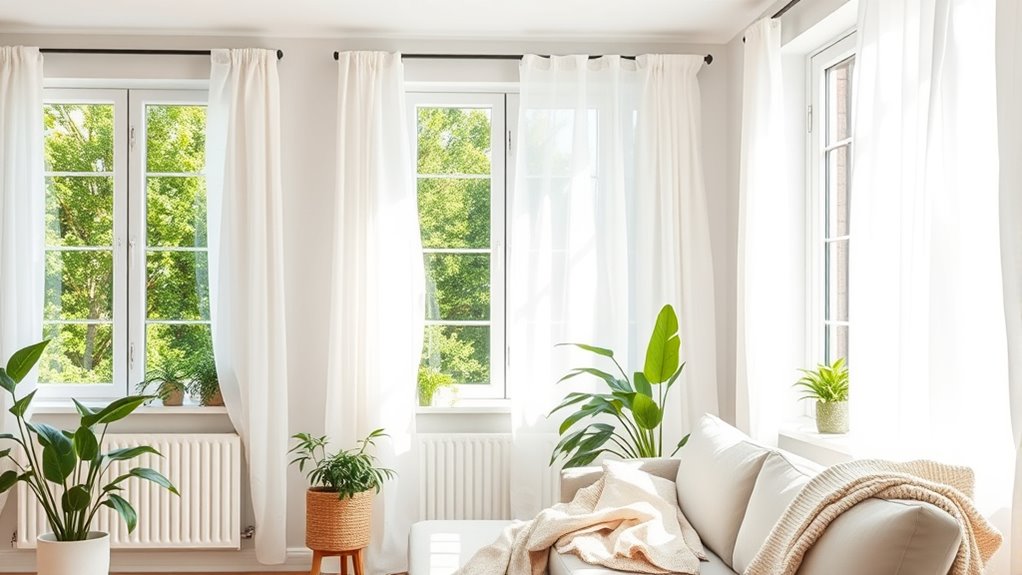
Opening windows and improving ventilation is one of the quickest ways to invigorate your home’s air. By opening your windows, you encourage air exchange, replacing stale indoor air with fresh airflow from outside. This simple step considerably reduces indoor pollutants and increases oxygen levels, making your space feel brighter and healthier. To maximize this effect, open windows on opposite sides of your home to create a cross-breeze, boosting air movement. Even just a few minutes of ventilation can make a noticeable difference in air quality. Keep in mind that the type of outdoor air matters; avoid opening windows during high pollution or allergy seasons. Regularly revitalizing your indoor air with natural ventilation is a cost-effective and efficient way to improve your home’s overall atmosphere. Additionally, incorporating air quality monitoring can help you determine the best times to ventilate and ensure optimal indoor air conditions.
Clearing Clutter and Reducing Dust Sources
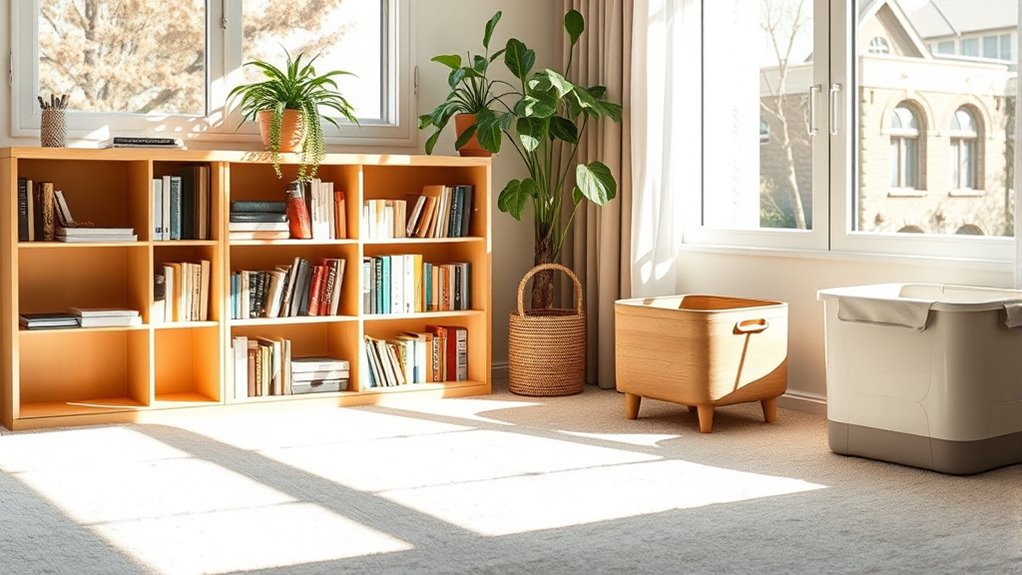
Start by clearing clutter from your living spaces to eliminate hiding spots for dust. Keep surfaces tidy and store items out of sight to minimize dust triggers. This simple step can make a noticeable difference in improving your indoor air quality quickly. Incorporating regular decluttering strategies can also help maintain a cleaner environment over time.
Declutter Living Spaces
Clearing clutter from your living spaces is an effective way to reduce dust buildup and improve air quality quickly. Start by organizing your belongings with simple storage solutions, like bins or baskets, to keep surfaces tidy. Proper storage organization minimizes hidden dust traps and makes cleaning easier. Next, assess your furniture arrangement; avoid overcrowding and keep furniture away from walls to allow airflow and prevent dust accumulation behind and underneath. Removing unnecessary items reduces surfaces where dust can settle. Focus on high-traffic areas and frequently touched surfaces to keep dust at bay. Additionally, incorporating airflow optimization strategies can help circulate air more effectively throughout your space. By decluttering and optimizing your storage and furniture layout, you create a cleaner environment that promotes healthier indoor air in no time.
Minimize Dust Triggers
Since clutter provides hiding spots for dust and allergens, removing unnecessary items from your home directly reduces dust triggers. Clearing surfaces and organizing spaces limit dust accumulation and make cleaning easier. Focus on reducing dust mite control by washing bedding regularly in hot water and using allergen-proof covers on pillows and mattresses. While air purifier alternatives like HEPA filters or good ventilation help, eliminating clutter minimizes dust sources at the core. Keep surfaces free of fabric and paper, which trap dust and allergens. Vacuum carpets and upholstery frequently with a vacuum equipped with a HEPA filter. Additionally, understanding foraging behaviors can help you identify natural sources of pollen and allergens that contribute to indoor air quality issues. By controlling dust sources and minimizing clutter, you create a cleaner environment that reduces airborne dust and allergens, improving your home’s air quality quickly and effectively.
Incorporating Indoor Plants for Natural Purification
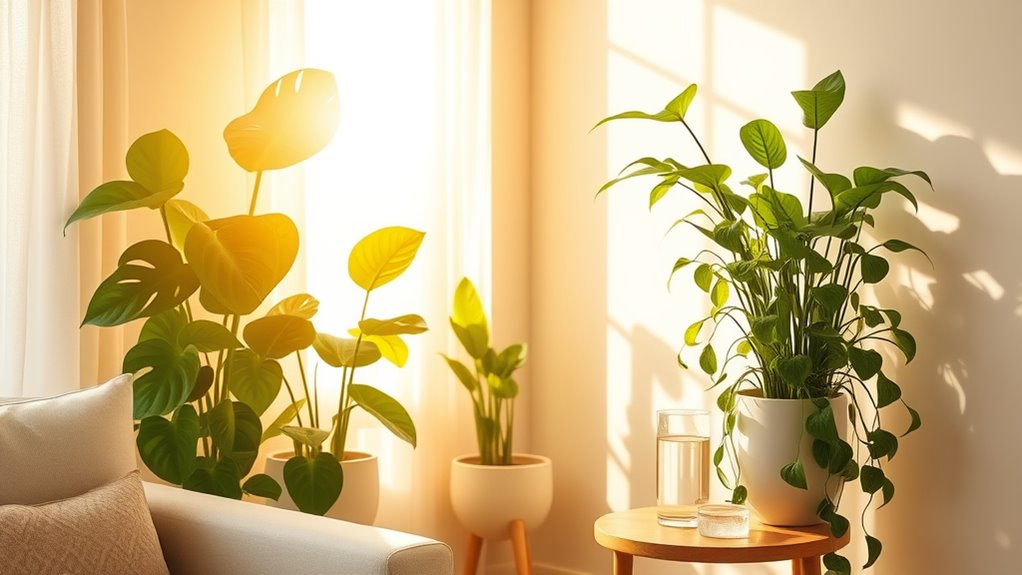
Adding the right indoor plants can ensure improve your home’s air quality by filtering out toxins. To maximize their benefits, place them in high-traffic areas and near sources of pollution. Choosing plants like snake plants or pothos ensures natural purification without much maintenance. Incorporating plants with air-purifying properties can further enhance indoor air quality and reduce allergy symptoms.
Plants That Filter Toxins
Indoor plants can effectively filter common household toxins, improving your home’s air quality naturally. Choosing the right indoor plant selection is key for toxin removal techniques, as some plants excel at absorbing pollutants like formaldehyde and benzene. For example, snake plants and pothos are known for their air-purifying abilities. Here’s a quick guide:
| Plant Name | Toxin Removal Strength |
|---|---|
| Snake Plant | Formaldehyde, Benzene |
| Peace Lily | Ammonia, Formaldehyde |
| Spider Plant | Carbon monoxide, Formaldehyde |
| Boston Fern | Formaldehyde, Toluene |
Additionally, selecting plants with durable materials can help ensure they thrive indoors and continue to purify the air effectively.
Optimal Placement Strategies
To maximize the air-purifying benefits of your indoor plants, strategic placement is essential. Position them near air vents or in areas with good airflow to enhance filtration. Avoid blocking furniture or windows that could hinder air circulation, as this limits their effectiveness. Place plants at eye level or on stands to ensure they receive sufficient light and air exposure. Keep them away from direct sunlight, which can dry out leaves, and avoid crowded spots that restrict airflow. Consider clustering plants in corners to create natural air purifiers. Regularly rotate their positions to ensure consistent air cleaning throughout your space. Proper placement not only boosts their cleaning power but also integrates them seamlessly into your home’s design. Additionally, understanding the spiritual significance of your plants can enhance your connection to nature and promote overall well-being.
Switching to Eco-Friendly Cleaning Products
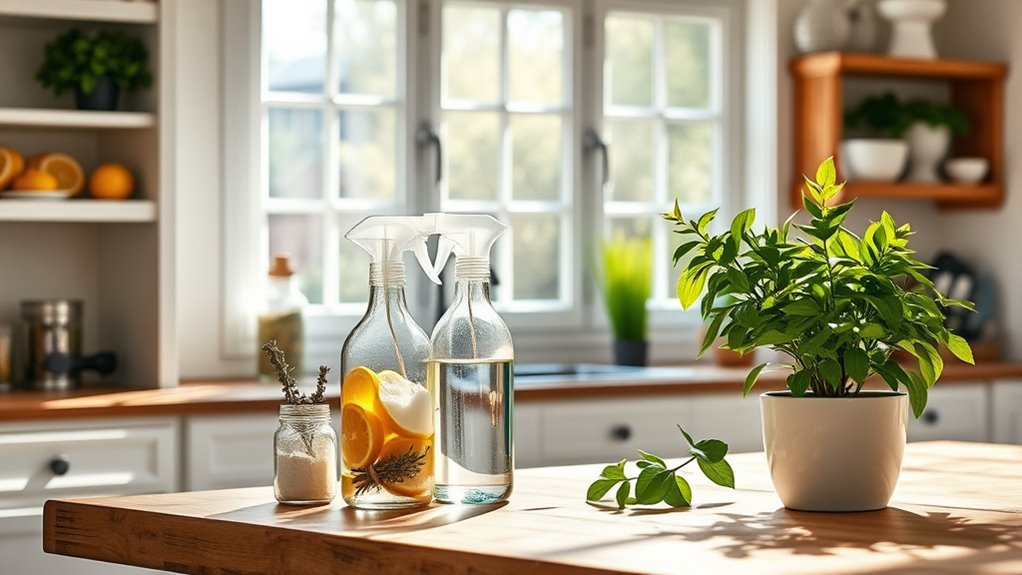
Switching to eco-friendly cleaning products is a simple yet impactful step toward improving your home’s air quality. Traditional cleaners often leave chemical residues that linger in the air, potentially causing respiratory issues or allergies. Eco-friendly options use natural ingredients, reducing harmful chemical exposure and lowering allergen levels. By choosing plant-based or biodegradable cleaners, you minimize irritants in your environment, making the air safer to breathe. These products are often free from volatile organic compounds (VOCs), which can contribute to indoor air pollution. Switching also encourages better ventilation habits, as many eco-friendly cleaners promote the use of open windows and fresh air during cleaning. Incorporating AI-powered safety monitoring devices can further help detect and reduce airborne toxins, creating an even healthier living space. Overall, this small change can considerably reduce airborne toxins and create a healthier, more comfortable living space.
Using DIY Air Fresheners and Natural Odor Absorbers

Creating your own air fresheners and natural odor absorbers is an effective way to improve your home’s air quality without relying on chemical-laden products. DIY air fresheners are simple to make and customizable with scents you love, like citrus or lavender. Natural odor absorbers help eliminate stubborn smells without masking them. You can use common household ingredients to achieve a fresher environment. Using proper maintenance such as regular filter changes can keep your air purifier functioning effectively and enhance your overall air quality.
- Vinegar and baking soda to neutralize odors
- Simmering citrus peels and herbs for a fresh scent
- Essential oils mixed with water in a spray bottle
- Activated charcoal in open bowls to absorb odors
- Coffee grounds placed in a bowl to mask unwanted smells
These tips help you naturally freshen and deodorize your space, creating a healthier home environment.
Managing Humidity Levels Effectively
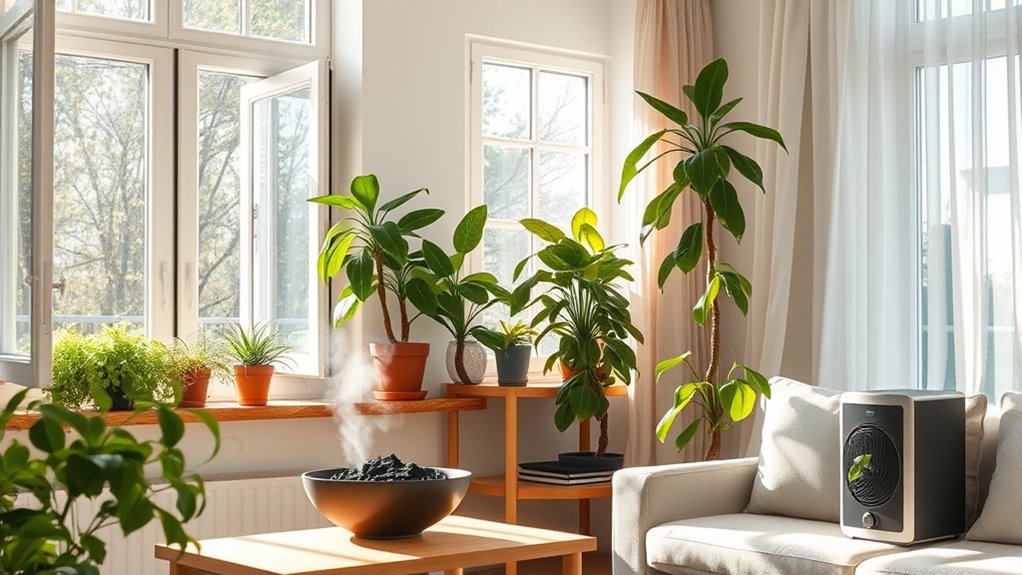
Controlling humidity levels is a key step in maintaining fresh, healthy indoor air. Proper humidifier maintenance ensures it runs efficiently and prevents mold growth or bacteria buildup. Regularly clean your humidifier, change filters as recommended, and use distilled water to avoid mineral deposits. Keep humidity levels between 30-50%, as too much moisture can promote mold and dust mites, while too little causes dryness. To manage moisture absorption, open windows when outdoor air is dry, and use natural absorbents like activated charcoal or baking soda to reduce excess humidity in damp areas. Monitoring with a hygrometer helps you stay aware of indoor moisture levels. Maintaining proper humidity levels also minimizes the chances of mold spores becoming airborne, further improving air quality. By maintaining balanced humidity, you create an environment that’s comfortable, reduces allergens, and prevents mold growth—all without expensive gadgets.
Regularly Changing and Maintaining Air Filters
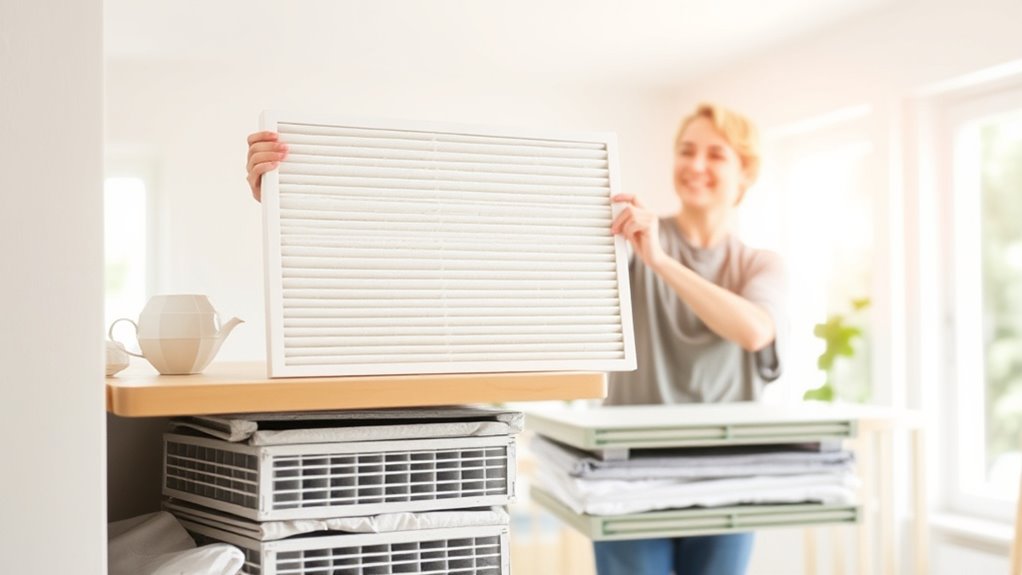
Regularly changing and maintaining your air filters is essential for ensuring good indoor air quality. When you perform regular air filter replacement, you prevent dust, allergens, and pollutants from circulating in your home. Proper filter maintenance also extends the lifespan of your HVAC system and improves its efficiency. Check your filters monthly, especially during allergy season or heavy use, and replace them as needed—typically every 1-3 months. Keep track of filter changes to avoid neglect. Using high-quality filters suited for your system makes a difference. Remember, clean filters reduce indoor pollutants and support healthier air. Regular filter maintenance is a simple but vital step toward cleaner, fresher air in your home.
- Check filters monthly
- Replace filters as needed
- Use correct filter size and type
- Keep track of filter changes
- Clean or vacuum filter housing
Practicing Daily Habits for Better Air Quality

Practicing daily habits can substantially improve your home’s air quality over time. Many air quality myths suggest quick fixes, but consistent routines matter more than gadgets. Understanding indoor air quality standards helps you set realistic goals. Focus on simple habits like opening windows daily, avoiding smoking indoors, and reducing clutter that traps dust. These actions keep pollutants at bay and promote fresh air.
| Habit | Impact |
|---|---|
| Ventilating regularly | Reduces indoor pollutants and stale air |
| Keeping surfaces clean | Limits dust and allergen buildup |
| Avoiding smoking indoors | Prevents harmful smoke from lingering |
Monitoring and Keeping Track of the Results
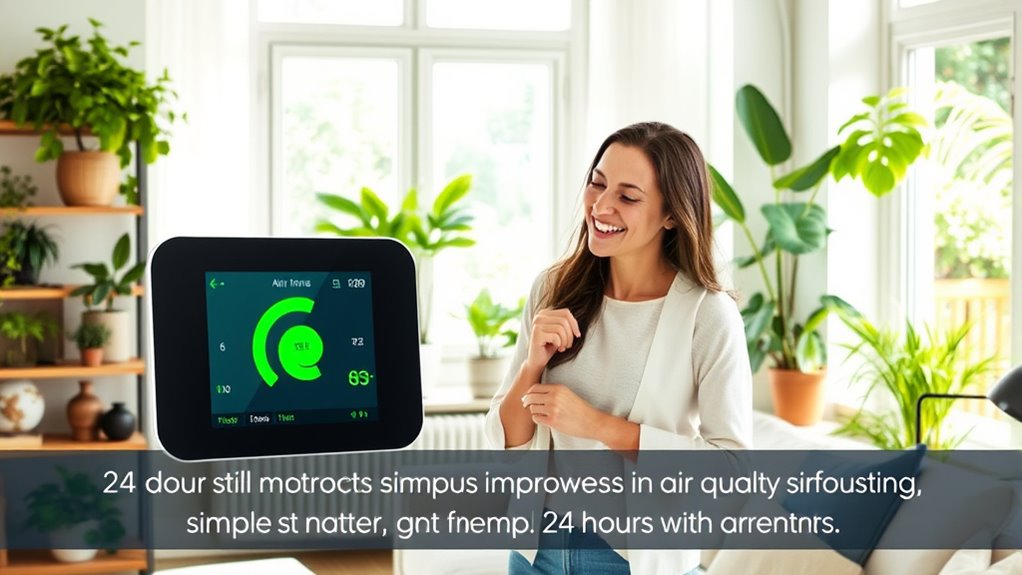
Tracking the results of your air quality efforts helps you understand what’s working and where to improve. Use reliable sensors and regularly calibrate them to guarantee accurate readings. Keep an eye on changes over time by visualizing data with simple charts or apps—this makes patterns easier to spot. Consistent data collection allows you to compare before and after results, confirming the effectiveness of your actions. Adjust your strategies based on real data rather than assumptions. Remember, sensor calibration is key to trustworthy measurements, and data visualization simplifies interpretation. By staying diligent, you’ll know precisely how your efforts impact your home’s air quality, enabling ongoing improvements.
Regularly calibrate sensors and visualize data to track improvements and optimize your home’s air quality efforts.
- Regular sensor calibration
- Using data visualization tools
- Tracking particulate and VOC levels
- Comparing data over days or weeks
- Identifying trends and anomalies
Frequently Asked Questions
How Can I Identify Hidden Sources of Indoor Air Pollution?
To identify hidden sources of indoor air pollution, start by inspecting common culprits like poorly ventilated areas and items with chemical off gassing, such as new furniture or cleaning products. Use ventilation strategies like opening windows and using exhaust fans to improve airflow. Pay attention to musty odors or persistent allergies, which can signal unseen pollutants. Regularly check for mold and consider air quality monitors to detect hidden pollutants effectively.
Are There Natural Ways to Reduce Pet Dander and Allergens?
You can reduce pet dander and allergens naturally by using air purifying plants like snake plants or spider plants, which help filter indoor air. Regular natural cleaning, such as vacuuming with a HEPA filter and dusting often, also minimizes allergens. Keep pets out of bedrooms and wash their bedding frequently. These simple steps, combined with natural cleaning routines, can considerably improve your home’s air quality without expensive gadgets.
What Indoor Activities Can Improve Air Quality Without Equipment?
You might find that opening your windows and daily ventilation naturally refreshes your indoor air, reducing pollutants without equipment. Adding air purifying plants like snake plants or pothos can also boost air quality effortlessly. These simple activities, combined with regular movement and cleaning, create a healthier environment. Coincidentally, your home feels fresher and more vibrant, proving that small, natural steps have a big impact on breathing easier every day.
How Do Indoor Air Quality Tips Vary for Allergy Sufferers?
If you’re allergy sufferers, your indoor air quality tips focus on reducing allergens. Use air purifiers with HEPA filters to trap pollen, dust, and pet dander. Incorporate allergy-friendly plants like spider plants or snake plants, which help filter toxins naturally. Keep windows closed during high pollen seasons and wash bedding regularly. These steps help create a safer, more comfortable environment, reducing allergy symptoms and improving your overall air quality.
Can Certain Household Materials Worsen Indoor Air Pollution?
Certain household materials can worsen indoor air pollution, especially if they emit volatile organic compounds (VOCs). Items like paints, cleaning products, and synthetic furniture can release harmful fumes. To combat this, you can DIY air purifiers and incorporate indoor plant benefits, which naturally filter toxins. These simple steps help improve air quality without expensive gadgets, making your home healthier and safer for everyone.
Conclusion
By taking these simple steps, you’ll notice a difference in your home’s air quality faster than you think. But there’s one secret trick that can make all the difference—something you haven’t tried yet. Curious? Stay tuned, because when you discover this final surprise, you’ll open the full potential of your fresh, clean indoor air. Ready to transform your space? The best is yet to come.









